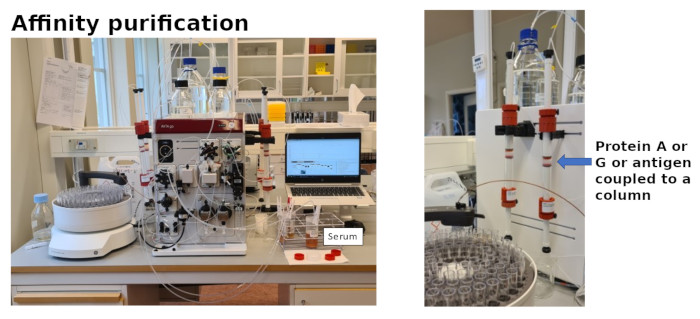| Affinity purified antibodies are obtained though so-called affinity chromatography, which can result in either: (1) a total immunoglobulin fraction, if conducted on Protein A or G (for immunoglobulins of IgG class, including subclasses like IgG1, IgG2, etc.) or (2) specific antibodies against the target protein we aim to detect. What is a difference between these types of purifications, and what are the advantages? Each of these purification methods use the principle of affinity. However, in case (1), total immunoglobulin (IgG) binds through its Fc part, which has affinity for Protein A or G. Therefore, the total IgG pool is purified, and the compounds of serum that contribute to background signals are removed. The resulting pool contains 0.5 - 5 % of the specific antibody. In case (2), a column with the antigen (protein or peptide) used to elicit the antibody in question, is used. This way, specific antibodies, which bind through their antigen-binding domain, are purified. This results in a specific antibody fraction, with > 95 % purity. Both purifications yield working antibodies. However, obtaining a specific antibody fraction makes method (2) more suitable for the detection of proteins of low expression, as in immunolocalization, antibody labelling and chromatin immunoprecipitation (ChIP). |  Make sure that the antibody product information sheet contains not only information about affinity purification, but also which type of purification was employed. Antibodies can either be purified to a total immunoglobulin fraction, which will be described as Protein A or G purified, or to a specific antibody fraction, which will be described as antigen purified. To compensate for the lower amount of specific antibodies/tube in a total immunoglobulin fraction, antibody suppliers will aliquote a larger volume/tube. Therefore, 150 µg of a total immunoglobulin fraction, may still contain less of the specific antibodies, than 50 µg of an affinity purified antibody. |
Latest
Is wild type a wild type?2025-12-29 Why an antibody may detect tagged protein but not endogenous one and in some cases endogenous protein but not its tagged version?
2025-10-30 Calclulated and aparent molecular weight of detected protein is different, why?
2025-10-09 How to chose right loading control for Western blot?
2025-10-06 Is an antibody going to work in a technique I am planning to use it in?
2025-09-30 Antibody reactivity to recombinant protein,does not validate antibody specificity in endogenous sample
2025-08-20 Can aggregated antibody be still used?
2025-08-15 Blot Once, Probe Twice - when such approach can be beneficial?
2025-07-31 Why should glycerol not be added, to stabilize antibodies in serum?
2025-06-27 Can methanol in transfer buffer be replaced by a less toxic alternative?
2025-05-12
Archive
- December - 2025
- October - 2025
- September - 2025
- August - 2025
- July - 2025
- June - 2025
- May - 2025
- April - 2025
- March - 2025
- February - 2025
- January - 2025
- December - 2024
- November - 2024
- September - 2024
- July - 2024
- June - 2024
- May - 2024
- March - 2024
- February - 2024
- December - 2023
- November - 2023
- September - 2023
- July - 2023
- May - 2023
- March - 2023
- January - 2023
- December - 2022
- November - 2022
- October - 2022
- September - 2022
- August - 2022
- June - 2022
- May - 2022
- March - 2022
- February - 2022
- January - 2022
- November - 2021
- October - 2021
- August - 2021
- June - 2021
- May - 2021
- April - 2021
- March - 2021
- February - 2021
- January - 2021
- December - 2020
- November - 2020
- October - 2020
- September - 2020
- August - 2020
- July - 2020
- June - 2020
- May - 2020
- April - 2020
- March - 2020
- January - 2020
- November - 2019
- October - 2019
- March - 2019
- April - 2017
- February - 2017
- May - 2016
- February - 2014
- September - 2013
- December - 2010
